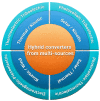Energy-Aware System Design for Autonomous Wireless Sensor Nodes: A Comprehensive Review
- PMID: 33466681
- PMCID: PMC7828785
- DOI: 10.3390/s21020548
Energy-Aware System Design for Autonomous Wireless Sensor Nodes: A Comprehensive Review
Abstract
Nowadays, wireless sensor networks are becoming increasingly important in several sectors including industry, transportation, environment and medicine. This trend is reinforced by the spread of Internet of Things (IoT) technologies in almost all sectors. Autonomous energy supply is thereby an essential aspect as it decides the flexible positioning and easy maintenance, which are decisive for the acceptance of this technology, its wide use and sustainability. Significant improvements made in the last years have shown interesting possibilities for realizing energy-aware wireless sensor nodes (WSNs) by designing manifold and highly efficient energy converters and reducing energy consumption of hardware, software and communication protocols. Using only a few of these techniques or focusing on only one aspect is not sufficient to realize practicable and market relevant solutions. This paper therefore provides a comprehensive review on system design for battery-free and energy-aware WSN, making use of ambient energy or wireless energy transmission. It addresses energy supply strategies and gives a deep insight in energy management methods as well as possibilities for energy saving on node and network level. The aim therefore is to provide deep insight into system design and increase awareness of suitable techniques for realizing battery-free and energy-aware wireless sensor nodes.
Keywords: compressive sensing; energy efficiency; energy harvesting; energy management; energy prediction; energy saving; hybrid energy harvesting; wake-up receiver; wireless energy transfer; wireless sensor networks.
Conflict of interest statement
The authors declare no conflict of interest.
Figures










References
-
- Kanoun O., Keutel T., Viehweger C., Zhao X., Bradai S., Naifar S., Trigona C., Kallel B., Chaour I., Bouattour G., et al. Next Generation Wireless Energy Aware Sensors for Internet of Things: A Review; Proceedings of the 15th International Multi-Conference on Systems, Signals and Devices (SSD); Hammamet, Tunisia. 19–22 March 2018.
-
- Min M., Wan X., Xiao L., Chen Y., Xia M., Wu D., Dai H. Learning-Based Privacy-Aware off Loading for Healthcare IoT With Energy Harvesting. IEEE Internet Things J. 2019;6:4307–4316. doi: 10.1109/JIOT.2018.2875926. - DOI
-
- Peruzzi G., Pozzebon A. A Review of Energy Harvesting Techniques for Low Power Wide Area Networks (LPWANs) Energies. 2020;13:3433. doi: 10.3390/en13133433. - DOI
-
- Kanoun O. Energy Harvesting for Wireless Sensor Networks: Technology, Components and System Design. De Gruyter Oldenbourg; Berlin, Germany: 2019.
-
- Zhao X., Keutel T., Baldauf M., Kanoun O. Energy harvesting for a wireless-monitoring system of overhead high-voltage power lines. Iet Gener. Transm. Distrib. 2013;7:101–107. doi: 10.1049/iet-gtd.2012.0152. - DOI
Publication types
Grants and funding
LinkOut - more resources
Full Text Sources
Other Literature Sources

